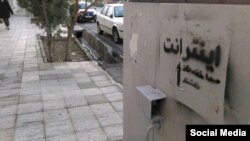The Research Center of the Iranian parliament (Majles) has estimated that about 190 trillion rials have been spent on setting up the National Information Network (NIN) by last year.
The amount quoted is hard to estimate in U.S. dollars since the rial has steadily declined over the years. But if the current official exchange rate is applied the expenditure comes to at least 4.5 billion dollars.
The Shi'ite clergy-dominated Iran has been restricting access to the World Wide Web for two decades, but the idea of an Iran-only intranet, which the government calls a NIN, was first proposed by the hardline President Mahmoud Ahmadinejad's administration in 2005.
Iran’s Supreme Leader Ali Khamenei has repeatedly criticized the lack of progress in launching NIN or intranet, asserting, "Unfortunately, there has been a lack of endeavor in launching the National information Network in the country, and what should have been done, has not been done, so far".
Thousands, if not millions of websites are blocked in Iran. While most are deemed morally corruptive, a smaller number are news and political websites, which are the real threat to the political system of the Islamic Republic that partly depends on controlling information and dissent.
NIN is an intranet that relies on the Internet to function. However, a domestic intranet based on the Internet Protocol will prevent data requests from being routed outside the country. NIN will allow censorship of the net and only provide access to authorized content. VPNs that many Iranians use to access blocked websites cannot function in the NIN.
After initial studies, the project was eventually renamed the National Information Network, and in 2010 it was mentioned in the Fifth Development Plan Act. Under the plan, the National Information Network was to be completed by the end of 2016.
During the recurrent anti-establishment protests in Iran in recent years, disconnecting user access to the Internet and disabling all messaging systems have been regularly taken by the Islamic Republic intelligence and security organs.
President Hassan Rouhani’s administration has poured millions of dollars into the NIN, offering financial incentives to entice Iranians to use it over the worldwide web while granting the state greater surveillance capabilities and control over the content NIN hosts.
Rouhani has repeatedly insisted that by launching NIN "people will not need foreign [networks] to meet their needs."
Iran is already blocking tens of thousands of websites and Rouhani's remark about not needing foreign networks simply means stronger censorship.
Some in the Rouhani administration have tried to present NIN in a positive light. "Speaking about the expansion of the National Information Network and independence in cyberspace does not mean shutting down the Internet and living in the Stone Age. The two (NIN and Internet) are complementary," Alireza Moezzi, the communications deputy of the Presidential Office maintained in a tweet.
"Saying we must cut connections with the [outside] world is a sign of inability to understand life in a world of networks," Moezzi added in his tweet.






